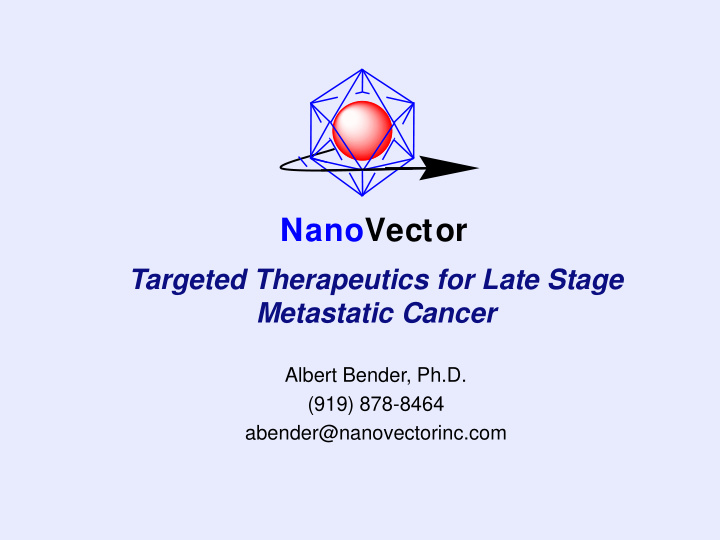



NanoVector Targeted Therapeutics for Late Stage Metastatic Cancer Albert Bender, Ph.D. (919) 878-8464 abender@nanovectorinc.com
Metastatic Cancer Current Therapies Do Not Work Ovarian Cancer 5 Year Survival Rate Problems: Multidrug resistance (MDR) Maximum tolerated dose (MTD) limitation Cancer at advanced stage when diagnosed NanoVector
Solution: Targeted Nanoparticle Drug Delivery Biologic Nanoparticle (Plant Virus) Low cost De-risk Stable in blood De-risk Tumor Auto delayed release Cell De-risk Non-immunogenic (in human food chain) 36 nm enables endocytosis Doxorubicin cancer therapeutic (DOX) Nanoparticle well suited to DOX FDA approved De-risk De-risk Broad efficacy 2 Stage Targeting : N-cadherin receptor: highly expressed on most late stage solid tumors Nuclear Location Signal (NLS) delivers therapeutic to site of action Potential: Single formulation to treat De-risk multiple late stage cancers – Same Cell Surface biomarker NanoVector
N-Cadherin Targeting N-cadherin expression is almost universal in metastatic cancers N-cadherin is an adhesion molecule on normal cells Space between N-cadherin-mediated cell junctions is too small for nanoparticle access E-cadherin to N-cadherin switch occurs on cell surfaces when cancer becomes metastatic NanoVector
Formulation Overcomes MDR and MTD MTD 1: DOX Chemotherapy agent isolated from blood cells & other organs MDR: DOX Chemotherapy agent isolated from MDR MTD 2: N-cadherin secretory pathways targeting enables higher intracellular drug 10x MTD dose + concentration longer dosing schedule MTD 3: Nuclear targeting delivers anti-cancer drug to site of action Greater safety and efficacy NanoVector
NanoVector Lead Drug: NVI-9010 Demonstrated Efficacy in Animals: Malignant melanoma (2011 and April 2014) Ovarian cancer (May 2014) Plan for Non-Invasive Companion Diagnostics SPECT imaging of tumor with targeted Plant Virus Nanoparticle (PVN) to qualify patient for therapy Pharmacodynamics imaging biomarker to monitor relationship of N-cadherin expression to the progression of disease NanoVector
Biologic Simplifies Manufacturing Nanoparticles produced in plants – Low Cost De-risk Cancer drug loaded via diffusion De-risk Single step aqueous process for DOX loading and peptide attachment De-risk Low cost – high yield De-risk Manufacturing safety, lower of cost materials and disposal De-risk 37 nm 17 nm NanoVector
Capital Efficiency: cGMP Compliant Plant Partner Leverage $21M GMP Greenhouse Facility in De-risk Research Triangle Park for plant growth Only small isolated greenhouse required for De-risk virus transfection NanoVector
Company Organized August 2007 7 employees Funded by $1.8M in grants and loans Research Augmented NCSU Sponsored Research NCSU Facilities use agreement Seeking joint development opportunities: Extend IP of existing drugs To increase efficacy and specificity of new drugs Joint development of new therapeutics NanoVector
Management Team Chief Executive Officer - Albert D. Bender, Ph.D. A successful serial entrepreneur who has provided the strategic vision and leadership for 4 high technology companies. Chief Scientific Officer - Bruce J. Oberhardt, Ph.D. Has led and/or participated in a number of first-of-a-kind technological developments including “CoaguChek” and founded Cardiovascular Diagnostics: a successful IPO. Board of Directors - William P. Peters, MD, PhD, MBA CEO of Adherex, a clinical stage oncology drug company, from 2003, to 2009. Formerly Dr. Peters served on the faculty at Harvard , Duke, and Wayne State University and was Associate Director, Duke Cancer Center and Director and CEO of the Karmanos Cancer Institute in Detroit NanoVector
Series A Financing Seeking $3M equity investment to match NCI Phase IIB grant ($6M total) Use of Funds Complete IND-enabling studies IND submission Phase 1 clinical trial metastatic cancer patients Will screen patients for target cell surface receptor NanoVector
More recommend